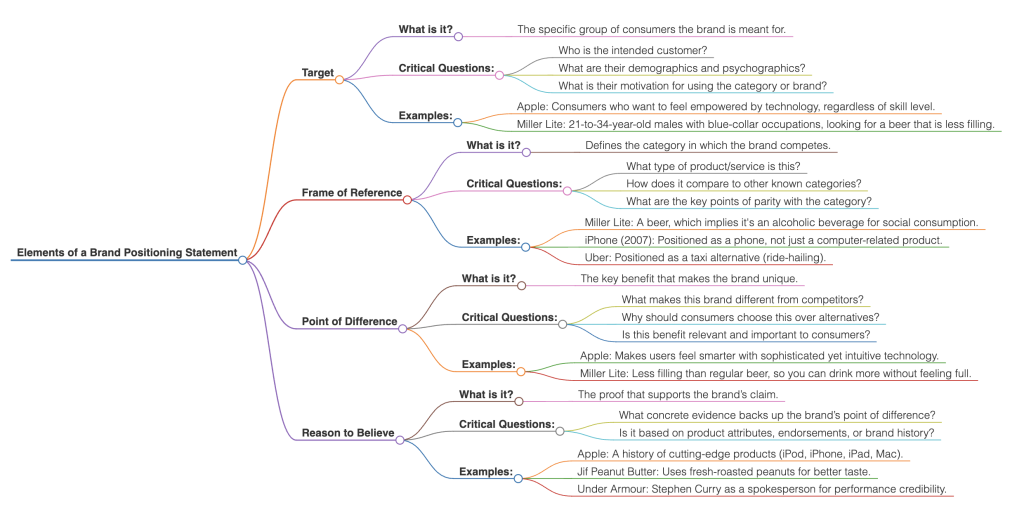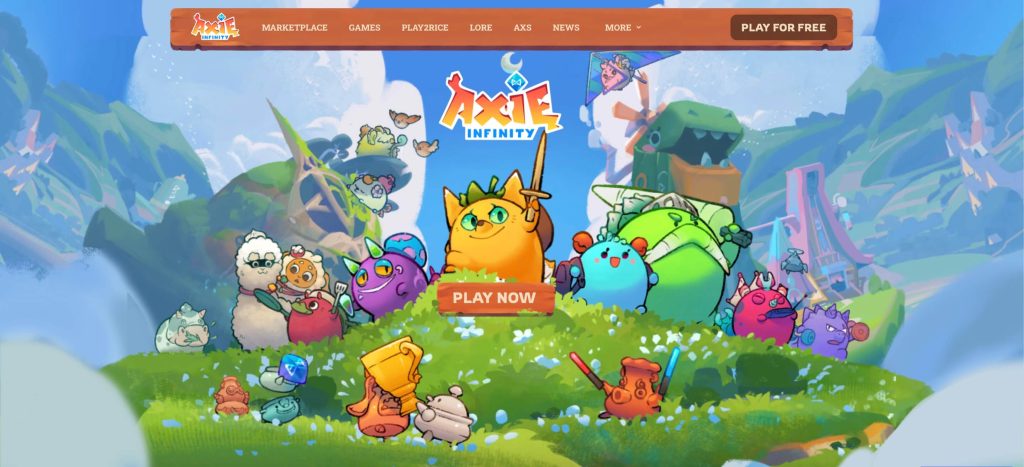A Brand Positioning Statement is your brand’s strategic foundation. Your brand’s DNA. A clear guide that aligns and directs all customer-facing decisions related to your brand.
It clarifies who your brand is speaking to, how it fits into their lives, and what unique value it offers. It conveys to the customer what makes you different. And what makes you insanely great at what you do.
When you get your brand positioning statement right, it becomes the foundation for everything. Every product decision, marketing campaign, and customer interaction. It’s the north star that guides your entire organization to stand out among your competitors, and gain an edge by leaning into what makes you unique.
Elements of a Brand Positioning Statement
The brand positioning statement is an internal, strategic document that succinctly describes who you serve, how you compete, what makes you unique, and why customers should believe in you.
A brand positioning statement consists of four key elements that work together to define how your brand connects with customers:
- The Target – Your ideal customers
- The Frame of Reference – The category or context in which your brand competes
- The Point of Difference – What sets you apart from rivals
- The Reason to Believe – Proof or evidence that backs up your brand’s claims

Although it’s not a public-facing ad or tagline, this statement is the cornerstone for every consumer-facing decision, from product design, marketing campaigns, advertising creative, taglines, channel decisions, you name it. Let’s look at an example of a brand positioning statement.
A Brand Positioning Statement: Elwood

Here’s a hypothetical Brand Positioning Statement for Elwood, the LA-based streetwear and apparel brand. This illustrates how we might capture their essence in a concise format and help us understand the different elements of the brand positioning statement.
“For style-conscious individuals seeking clean, comfortable streetwear, Elwood delivers timeless, minimal designs that blend modern trends with everyday versatility—because we use high-quality fabrics and a refined design approach that stands out from mainstream fast fashion.”
Target
Style-conscious individuals who appreciate modern streetwear but also want everyday versatility. This audience values comfort, quality, and understated design.
Frame of Reference
Elwood positions itself within the casual/lifestyle apparel or streetwear category, emphasizing its contemporary approach to everyday clothing.
Point of Difference
Elwood combines timeless minimal designs with modern street trends. Rather than overly flashy or fast-fashion pieces, Elwood focuses on comfort and simplicity that can be dressed up or down.
Reason to Believe
The brand’s commitment to high-quality fabrics and a refined design approach gives credibility to its claims. Elwood’s aesthetic is clean and consistent, setting it apart from trend-driven brands that rotate styles too quickly.
Getting Deeper with the Four Pillars of Brand Positioning
As we’ve already defined, each component of a brand positioning statement—target, frame of reference, point of difference, and reason to believe—serves as a foundational pillar. When crafted correctly, these pillars work together to create an unshakeable position in your market.
By mastering these elements, you’ll create a positioning statement that guides strategic decisions and makes your brand genuinely valuable to your target audience. In the next section, we’ll explore the theory behind each element, then bring these concepts to life through a real-world analysis.
We’ll look at Axie Infinity, a leader in Web3 gaming. This approach will demonstrate how thoughtful positioning can create a powerful competitive advantage.

Target: Who is your audience and customer?
Choosing your target audience is one of the most critical decisions you’ll make. It’s all about demographics, market size, and understanding who will truly value what you’re creating. Your target choice needs to align with your company’s goals, the competitive landscape, and match your resources. Most importantly, it needs to reflect a deep understanding of your potential customers’ needs and motivations.
Let’s see how this works in practice with Axie Infinity. Their target is “forward-thinking gamers and web3 natives who crave true ownership of their digital assets.” This isn’t a random choice. It’s precisely defined based on both behavior and motivation:
- They focus on gamers who are open to new technology
- They specifically target people who value ownership of digital assets
- They recognize their audience’s desire for deeper engagement in their gaming experience
Notice how Axie’s target definition goes beyond simple demographics. Instead of just saying “young tech-savvy gamers,” they define their audience by their mindset and desires. This deeper understanding helps inform everything from product development to marketing strategy.
Your target definition doesn’t need to include every characteristic that distinguishes your audience. What matters is including enough detail to guide your decisions about what you’re offering and how you’ll differentiate it. Sometimes behavioral characteristics are most important. Other times, demographics matter more. The key is focusing on the characteristics that most directly relate to why someone would choose your brand.
Remember: your target audience choice will influence every aspect of your brand strategy – from pricing to distribution to communication. Choose carefully, because once established, your brand’s image and audience become intertwined, making significant changes challenging later on.
Frame of Reference: What category does your brand compete in?
The frame of reference tells people what space you’re competing in. This sets expectations about what your brand does and who you’re competing against.
Sometimes this is straightforward. You’re entering an established category and need to prove you belong there. Other times, you’re creating something entirely new and need to help people understand what you are by relating to something they already know.
Let’s look at how Axie Infinity handles this. Their frame of reference is “Web3 gaming.” But this wasn’t a category most people understood when they launched. To help people grasp the concept, they had to connect it to traditional gaming while emphasizing the new elements: NFTs, play-to-earn mechanics, and community-driven ecosystems.
This positioning accomplishes two things:
- It places them in the broader gaming category, so people understand it’s about entertainment and play
- It specifies they’re pioneering a new subcategory (Web3 gaming) with distinct characteristics
When you’re choosing your frame of reference, you have three main options:
- Claim membership in an established category (but make sure you have the essential features people expect)
- Compare yourself to a familiar category to help people understand something new
- Show the goal or problem you solve for customers
Your choice matters because it shapes how people understand what you offer and who you’re competing against. And sometimes, like Axie Infinity, you might need to do more than one of these things to help people understand your place in the market.
Point of Difference: What Makes You Unique?
Your point of difference is the benefit that sets you apart from competitors. It’s not just a feature – it’s the value you deliver that matters to your customers and that you can credibly own in the market.
Think carefully about your position in the market when choosing your point of difference:
- Category leaders often own the primary benefit people seek (like “best performance”)
- Challenger brands usually need to focus on distinct niche benefits
- New category creators, like Axie Infinity, have the opportunity to define entirely new benefits
Let’s look at Axie Infinity’s point of difference: “empowers players to collect, breed, and battle unique NFT creatures.” It’s about creating a new kind of value through true digital ownership and player-driven economies. They didn’t just pick a benefit within traditional gaming. They created an entirely new value proposition.
Reason to Believe: Why Should Customers Trust You?
A point of difference is only as good as your ability to prove it. Your reason to believe provides concrete evidence that your brand can deliver on its promises. There are typically two ways to establish this proof:
- Through Attributes:
- Product features
- Technology
- Heritage or history
- Origin or source
- Through Image:
- User experiences
- Community proof
- Expert endorsements
- Demonstrated results
Let’s see how Axie Infinity handles this. They back up their point of difference with “cutting-edge blockchain technology and a vibrant, reward-driven global community.” This is powerful because it combines:
- Technical proof: Their blockchain infrastructure proves they can deliver true digital ownership
- Social proof: Their active community demonstrates the real economic value being created
- Market proof: Their position as a pioneer in Web3 gaming adds credibility to their claims
The key is choosing proof points that are both meaningful to your audience and uniquely connected to your point of difference. Your reasons to believe should make your customers think, “Yes, that makes sense – I can see why they can deliver on their promise.”
Bringing It All Together: The Axie Infinity Example
Let’s see how all four elements work together in Axie Infinity’s brand positioning statement:
“For forward-thinking gamers and web3 natives who crave true ownership of their digital assets, Axie Infinity is the pioneering Web3 game that empowers players to collect, breed, and battle unique NFT creatures—because it’s built on cutting-edge blockchain technology and fueled by a vibrant, reward-driven global community.”
Here’s how each element strengthens their market position:
Target: Forward-thinking gamers and web3 natives who crave true ownership of their digital assets
- Focuses on innovative gamers open to new technology
- Targets people who value digital asset ownership
- Emphasizes the desire for deeper gaming engagement
Frame of Reference: Pioneering Web3 game
- Places them in the familiar gaming category
- Establishes leadership in the new Web3 gaming subcategory
- Bridges traditional gaming with blockchain innovation
Point of Difference: Empowers players to collect, breed, and battle unique NFT creatures
- Creates new value through true digital ownership
- Offers unique player-driven economies
- Delivers both entertainment and economic opportunity
Reason to Believe: Built on cutting-edge blockchain technology and fueled by a vibrant, reward-driven global community
- Technical proof through blockchain infrastructure
- Social proof via active community engagement
- Market proof as a category pioneer
Crafting Your Brand’s Positioning Statement
A well-crafted brand positioning statement is your strategic compass, guiding every decision that shapes your brand’s future. When you align your target audience, frame of reference, point of difference, and reason to believe, you create a foundation for competitive advantage.
Your positioning statement should:
- Define exactly who you serve and why you matter to them
- Place your brand in a clear competitive context
- Articulate unique value that competitors can’t easily match
- Provide concrete proof that builds trust
Take time to craft yours thoughtfully. Test it against market realities. Refine it as you learn. A strong positioning statement is about standing out today and building a brand that matters tomorrow.
Each element of your positioning statement should reinforce the others, creating a clear, compelling story about why your brand deserves to win in the marketplace. When done right, it becomes your blueprint for success.
